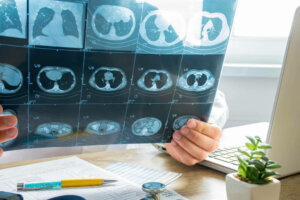Lung Cancer Diagnosis

Lung cancer is a complex disease. Not only is it the variant that causes the most cancer-related deaths each year (according to WHO data), but in its early stages, it can go unnoticed in many patients. The diagnosis of lung cancer consists of detecting malignant cells and then identifying which type they belong to.
As Johns Hopkins Medicine reports, detecting the disease is essential in order to improve prognosis. This is why patients should be aware of the symptoms and if they belong to any of the risk groups. Below we explore the options most used during the diagnosis of this condition.
Diagnosing lung cancer with imaging tests
The process of detecting the disease begins with a general assessment of the patient’s symptoms. The specialist will collect them and rule out some possible explanations. It will also take into account many factors, such as age, habits (smoking addiction, for example), family history, and previous conditions.
After doctors have collected all this information, they’ll begin the diagnosis of lung cancer based on the following imaging tests.
Chest x-ray

As the American Cancer Society points out, a chest x-ray is the first imaging test that specialists use to detect lung cancer.
It doesn’t provide complete information, and, in some cases, it can’t detect the initial stages of the disease. However, it’s a simple, inexpensive, and practical test that is part of the first line of diagnosis.
The x-ray may show abnormalities in the lungs, heart, and lymph nodes. Although it’s the first test, it should never be considered the last. Researchers note that up to 1/4 of chest X-rays are negative for patients who do have lung cancer.
Computed tomography
If the doctor found abnormal signs with the previous test or suspects the presence of cancer, they’ll continue with a CT scan.
Evidence indicates that this is a safe and reliable test to diagnose lung cancer compared to radiography. Its usefulness is that it’s able to show the size, shape, and position of tumors with much more precision.
It’s also helpful in finding out if the cancer has spread (metastasis). The images obtained allow the specialist to determine if there are traces of malignant cells in the adrenal glands, liver, brain, and other areas of the body.
Magnetic resonance
As a complement to the above, they may also opt for an MRI scan. This is often used to rule out cancer in other parts of the body, especially the spinal cord or brain.
Studies promote its use to detect particularly “elusive” episodes of lung cancer, and also to assess disease staging.
These three tests are the ones most used during the detection process. Other tests that doctors may use are positron emission tomography scans and bone scans. The latter is used to rule out possible dissemination to the bones.
Diagnosis of lung cancer with laboratory tests
The above examinations should give convincing signs that the patient has abnormalities in their lungs. The second step will be to determine if these are really cancer and, if so, what type they belong to. In this case, the following alternatives are used.
Sputum cytology
Sputum cytology consists of analyzing a sample of the mucus that’s produced by coughing. Samples are usually obtained from different days and times, as the presence of cancer cells often varies.
Although research has pointed out its limitations, it’s still part of the standard diagnosis because it’s effective for certain types of cancer (such as squamous cell lung cancer).
Thoracentesis
If there are signs of a pleural effusion (the accumulation of fluid in the pleura), a thoracentesis will be performed. To do this, the skin is numbed and the fluid is drained through a puncture in the ribs. The sample is then tested to see if this was caused by cancer (infections and heart problems also cause this).
Biopsy

The biopsy remains, in many cases, the only method that allows doctors to identify the presence of cancer. The specialist will use imaging tests to guide a needle that will remove a sample of the detected nodule.
This is subjected to laboratory tests to check for the presence of malignant cells. There are many types of biopsies, the most common are the following:
- Fine needle aspiration biopsy
- Transthoracic needle biopsy
- Core biopsy
- Bronchoscopy biopsy
The results of this and previous tests should be sufficient to detect the disease. With their help, the type of lung cancer can be diagnosed.
Other tests to detect lung cancer
Additional tests that the specialist can carry out as an adjunct are based on the suspicion of metastasis or the absence of convincing results with the previous ones. The American Lung Association consider the following:
- Blood test
- Endobronchial ultrasound
- Endoscopic esophageal ultrasound
- Mediastinoscopy
- Mediastinotomy
- Video-assisted thoracoscopic surgery
- Biomarker test
Differential diagnosis of lung cancer
Many diseases can explain the symptoms of lung cancer. The following list compiles only a selection of these:
- Tuberculosis
- Pneumonia
- Pleural effusion
- Heart diseases
- Chronic obstructive pulmonary disease (COPD)
- Pneumothorax
- Bronchitis
- Pulmonary fibrosis
- Sarcoidosis
- Pulmonary embolus
- Pulmonary edema
All these are considered in their context, as, according to the risk group you belong to, you can develop any one of these. Also, keep in mind that if you’re a persistent smoker, you have a greater chance of suffering from lung cancer.
Have a look at the following article to find out other causes of lung cancer.
Lung cancer is a complex disease. Not only is it the variant that causes the most cancer-related deaths each year (according to WHO data), but in its early stages, it can go unnoticed in many patients. The diagnosis of lung cancer consists of detecting malignant cells and then identifying which type they belong to.
As Johns Hopkins Medicine reports, detecting the disease is essential in order to improve prognosis. This is why patients should be aware of the symptoms and if they belong to any of the risk groups. Below we explore the options most used during the diagnosis of this condition.
Diagnosing lung cancer with imaging tests
The process of detecting the disease begins with a general assessment of the patient’s symptoms. The specialist will collect them and rule out some possible explanations. It will also take into account many factors, such as age, habits (smoking addiction, for example), family history, and previous conditions.
After doctors have collected all this information, they’ll begin the diagnosis of lung cancer based on the following imaging tests.
Chest x-ray

As the American Cancer Society points out, a chest x-ray is the first imaging test that specialists use to detect lung cancer.
It doesn’t provide complete information, and, in some cases, it can’t detect the initial stages of the disease. However, it’s a simple, inexpensive, and practical test that is part of the first line of diagnosis.
The x-ray may show abnormalities in the lungs, heart, and lymph nodes. Although it’s the first test, it should never be considered the last. Researchers note that up to 1/4 of chest X-rays are negative for patients who do have lung cancer.
Computed tomography
If the doctor found abnormal signs with the previous test or suspects the presence of cancer, they’ll continue with a CT scan.
Evidence indicates that this is a safe and reliable test to diagnose lung cancer compared to radiography. Its usefulness is that it’s able to show the size, shape, and position of tumors with much more precision.
It’s also helpful in finding out if the cancer has spread (metastasis). The images obtained allow the specialist to determine if there are traces of malignant cells in the adrenal glands, liver, brain, and other areas of the body.
Magnetic resonance
As a complement to the above, they may also opt for an MRI scan. This is often used to rule out cancer in other parts of the body, especially the spinal cord or brain.
Studies promote its use to detect particularly “elusive” episodes of lung cancer, and also to assess disease staging.
These three tests are the ones most used during the detection process. Other tests that doctors may use are positron emission tomography scans and bone scans. The latter is used to rule out possible dissemination to the bones.
Diagnosis of lung cancer with laboratory tests
The above examinations should give convincing signs that the patient has abnormalities in their lungs. The second step will be to determine if these are really cancer and, if so, what type they belong to. In this case, the following alternatives are used.
Sputum cytology
Sputum cytology consists of analyzing a sample of the mucus that’s produced by coughing. Samples are usually obtained from different days and times, as the presence of cancer cells often varies.
Although research has pointed out its limitations, it’s still part of the standard diagnosis because it’s effective for certain types of cancer (such as squamous cell lung cancer).
Thoracentesis
If there are signs of a pleural effusion (the accumulation of fluid in the pleura), a thoracentesis will be performed. To do this, the skin is numbed and the fluid is drained through a puncture in the ribs. The sample is then tested to see if this was caused by cancer (infections and heart problems also cause this).
Biopsy

The biopsy remains, in many cases, the only method that allows doctors to identify the presence of cancer. The specialist will use imaging tests to guide a needle that will remove a sample of the detected nodule.
This is subjected to laboratory tests to check for the presence of malignant cells. There are many types of biopsies, the most common are the following:
- Fine needle aspiration biopsy
- Transthoracic needle biopsy
- Core biopsy
- Bronchoscopy biopsy
The results of this and previous tests should be sufficient to detect the disease. With their help, the type of lung cancer can be diagnosed.
Other tests to detect lung cancer
Additional tests that the specialist can carry out as an adjunct are based on the suspicion of metastasis or the absence of convincing results with the previous ones. The American Lung Association consider the following:
- Blood test
- Endobronchial ultrasound
- Endoscopic esophageal ultrasound
- Mediastinoscopy
- Mediastinotomy
- Video-assisted thoracoscopic surgery
- Biomarker test
Differential diagnosis of lung cancer
Many diseases can explain the symptoms of lung cancer. The following list compiles only a selection of these:
- Tuberculosis
- Pneumonia
- Pleural effusion
- Heart diseases
- Chronic obstructive pulmonary disease (COPD)
- Pneumothorax
- Bronchitis
- Pulmonary fibrosis
- Sarcoidosis
- Pulmonary embolus
- Pulmonary edema
All these are considered in their context, as, according to the risk group you belong to, you can develop any one of these. Also, keep in mind that if you’re a persistent smoker, you have a greater chance of suffering from lung cancer.
Have a look at the following article to find out other causes of lung cancer.
- Bach P, Jett J, Pastorino U, Tockman M, Swensen S, Begg C. Computed tomography screening and lung cancer outcomes. Rev Port Pneumol. 2007 Nov-Dec;13(6):888-90. English, Portuguese.
- Khalil A, Majlath M, Gounant V, Hess A, Laissy JP, Debray MP. Contribution of magnetic resonance imaging in lung cancer imaging. Diagn Interv Imaging. 2016 Oct;97(10):991-1002.
- Stapley S, Sharp D, Hamilton W. Negative chest X-rays in primary care patients with lung cancer. Br J Gen Pract. 2006 Aug;56(529):570-3.
- Thunnissen FB. Sputum examination for early detection of lung cancer. J Clin Pathol. 2003 Nov;56(11):805-10.
Este texto se ofrece únicamente con propósitos informativos y no reemplaza la consulta con un profesional. Ante dudas, consulta a tu especialista.







